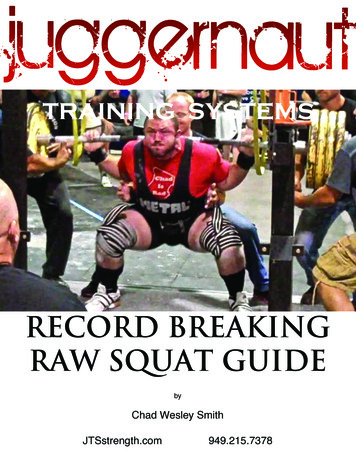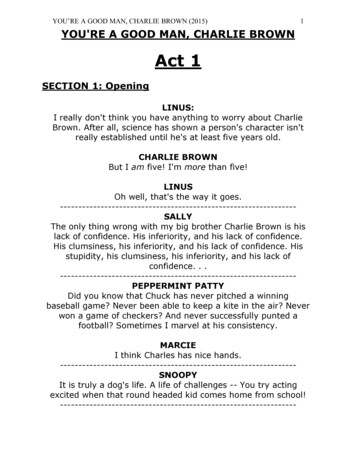
Transcription
RAW PT, v.4.0Further, Faster, Harder1
Table of ContentsTopicPagePurposePrinciples of ExerciseMovement PrepRecovery DrillStrength TrainingMuscular EnduranceHeavy Resistance TrainingPower/Power EnduranceGround BasePower DrillsPrinciples of Endurance TrainingRunning FormBarefoot/Minimalist RunningPrinciples of Movement Skills360 CoreElastic Band ResistanceMedicine Ball DrillsSpeed/Agility/CoordinationHybrid Guidance/DrillsTactical PTRAW AssessmentsOlympic LiftsKettlebellsScheduling 6168697984901022
PURPOSE OF RAW is to provide education and training that optimizethe physical/mental development and sustainment of the Regiment's mostlethal weapon - the individual --------------------------------The END-STATE OBJECTIVE OF RAW is to field self-sustainingsystems that ensure all Rangers: Achieve a level of physical fitness that is commensurate with thephysical requirements of Ranger missions. Understand and choose sound nutritional practices. Employ mental toughness skills to enhance personal and professionaldevelopment. Receive screening/education for injury prevention and prompt,effective, and thorough treatment/rehabilitation of injuries when theydo occur.3
RAW PhilosophyThe individual Ranger is the Regiment’s most lethal weapon.You don’t know how tough your next enemy will be. Assume he’ll be very tough.You don’t know exactly what the physical requirement will be on your nextmission. Assume it will be extremely demanding.Ranger missions require strength, endurance, and movement skills excelling in onlyone or two leaves you vulnerable to poor performance and/or injuries.Training hard is not enough; you have to train smart as well.As an individual, a team, a squad, or a platoon, you are only as strong as yourweakest link. Don’t have a weak link.Form matters. Master the exercise techniques and demand proper execution fromyour men.The body adapts to the stress you place upon it. This takes time. Cells aren’tnecessarily on the same schedule as your head and your heart. In other words, beconsistent, patient, and think of improvement over weeks and months, not days.Don’t crush yourself everyday. Respect the need for recovery. RAW schedulingguidance builds in some degree of recovery, but leaders must be attuned to their menand modify the training stress appropriately.Fuel the machine. Don’t train well then blow it with a lousy diet. Have a plan forhydration and meals/snacks and stick to it.Take care of your injuries before they become chronic. Playing hurt is necessary onoccasion, but do it too long and there may not be a therapy or surgery fix.Keep your head in the game. Historically, warriors have been defined more by theirminds than their bodies. Similarly, most athletes claim their performance is as muchmental as physical, yet they seldom train or have a plan for developing mentaltoughness. Rangers need to recognize their ideal performance state and be able to callit up at a moment’s notice.Learn all you can about your mind, your body, nutrition, and exercise, and then applythat to the task at hand making you and your Rangers the best tactical athletes onthe planet.Bottom Line: Train right, eat right, sleep right, and keep your head in the game.4
Principles of ExerciseProgression: Following this principle means that you take a systematic approach toincreasing the physical demands over time. For example, if your squad has beenperforming long runs of 35 minutes and you want to progress to 60, then you need a planfor doing so. The general rule-of-thumb is to progress time/distance by no more than 10%per week. When you do the math, you see that it will take about six weeks to safelyprogress from 35 to 60 minutes. The principle of gradual progression is just as importantfor resistance training. Start by mastering core stability and control of body-weightexercises. Add external resistance and/or volume (number of reps over a given period oftime) gradually as long as control of the movement is well-maintained. Many injuries canbe traced to attempting workouts that are beyond an individual’s current capability.Regularity: This one is pretty obvious. Rangers don’t generally have a problem withthis. However, two points should be noted. First, if for whatever reason you cannot do PTfor two or more consecutive weeks, assume you’ve lost some degree of fitness. Youshould then resume PT at a lower level and gradually build back up. Second, even thoughyou may be doing PT on a regular basis, if you stop doing a particular component of PT(agility or plyometric training, for example), then you should re-master the basics ofthose drills before jumping back into an aggressive workout. Note that endurance is lostfaster than strength.Overload: To improve strength, endurance, or movement skills, you must provide astimulus. This means moving outside your comfort zone progressively lifting a littlemore, running a little faster or farther, practicing agility drills that don’t come easy, etc. Itis extremely easy to overload. The challenge is to do it intelligently. You must apply theprinciples of progression and recovery together with overload.Variety: Over the years, researchers and trainers have learned that athletes maximizetheir potential by dedicating a given period of time to a particular aspect of physicaldevelopment, then changing the focus at regular intervals. For example, many strengthprograms begin with the focus on mass-producing workouts, then strength, lateremphasizing general power training, and finally move to activity-specific strength/powerdrills. Such regular changes to workouts force the body to continue adapting. If you staywith the same routine, the body becomes accustomed to it and development stops.Maintaining variety in a program also helps to control overuse injuries. If all of yourendurance training comes from running, you are more susceptible to stress-relatedinjuries (stress fracture, tendinitis, etc.). Finally, variety in physical training is absolutelynecessary to be prepared for the broad-ranging physical requirements of Ranger missions.Recovery: The principle of recovery is closely related to the principles of overload andprogression. Overload must be followed by some degree of recovery. Some workoutsdemand more recovery than others. Sessions that aggressively train speed, power,jumping/landing/cutting or heavy lifting should be followed by either a day of rest or PTthan involves a moderate session of some other component (an easy run/swim and some5
mat-based core training, for example). Regarding progression and recovery, someperiods, whether it is a day, a week, or several weeks, will involve PT that is relativelyeasy compared to the hardest days or training cycles. Another way of saying this is: youshould not be red-lining every day nor burned out at the end of each week. Attempting tomaintain maximal workouts for several months runs the risk of overtraining, which isrelated to not only muscles/bones/tendons stress injuries, but also disruption of hormonalbalance. By incorporating relatively less training intensity and volume during a portion ofthe training cycle, the body is much less likely to breakdown.Balance: For Rangers, a balanced approach to PT scheduling means your programconsistently incorporates training that develops strength, endurance, and movement skills(power, agility, coordination, etc). Taking this notion a step further, strength must bebalanced by performing some workouts with body-weight resistance, some withmoderate-heavy resistance, and some with a moderate resistance that is moved quickly(power training). Endurance should be balanced by performing a mix of aerobic andanaerobic training.Specificity: Following this principle ensures that you will be fit for the important stuff.Whenever the idea of fitness is discussed, the question ―Fit for what?‖ should be part ofthe discussion. For Rangers, the answer is ―Fit for current and potential Ranger trainingand combat missions.‖ This doesn’t mean that every workout must look like a combatmission. It does mean that you should always be aware of your big-picture PT objectivesand understand how each workout, each week, each month of PT contribute to it. At leastpart of a training cycle needs to focus directly on tactical fitness. Such training mustinvolve an operationally relevant degree of intensity and volume, but should be precededby general fitness development (strength, endurance, movement skills).Precision: This term refers to the biomechanical correctness of movement. We knowthrough observation and research that some movement patterns are efficient andeffective, while other are inefficient and possibly destructive (over time, likely to lead toinjury). For example, spinal stability not only protects the spine but also creates a stablebase of support from which the arms and legs can generate power. Rangers should studyand master optimal execution for all drills in the program. There will be times duringtraining when we must push ourselves through fatigue and perhaps sacrifice perfect form.However, these should be the exceptions and not the everyday norms.6
Understanding Movement Prep and RecoveryMovement preparation and recovery are vital pieces of the RAW PT program. Inthe past, they’ve been known as warm-up and cool-down. In keeping with the terms usedby most top trainers, the names have been change to reflect the intent of the drills.Movement preparation is a better term than warm-up. Preparing the body to movewell is precisely the goal. Warming the body is part of movement prep, but it is no moreimportant than the other two objectives of movement prep: loosening the joints/muscles,and priming the nerve to muscle messages. If warming were the only objective, you couldsit in a sauna and call it warm-up. After movement prep, Rangers should be prepared torun, lift, negotiate obstacles, play a sport, and execute a raid The movement prep recommended for Rangers is very similar to that used by topstrength and conditioning coaches. It is somewhat different than the 5-step warm-updescribed in the Army’s Physical Fitness Training FM (circa 1980s). While that warm-upwas based on sound principles at the time, in the past decade research has shown thatstatic stretching during warm-up is not necessary for injury prevention or performance.The term recovery is used instead of cool-down. Similar to the idea of warm-up asonly a component of movement prep, cooling down is only a small part of recovery. Theobjectives of recovery are 1) safely decrease heart-rate, respiratory rate, and bodytemperature, 2) improve functional flexibility; 3) replace nutrients, and 4) rest enough sothat the body is ready for subsequent PT or missions.Only the first two objectives are met on the PT field. This means that meetingobjectives three and four are a personal responsibility. Leaders must educate andmotivate their men to follow the nutritional and sleep guidelines put forth in the RAWclasses.It is clear that many individuals blow off cool-down and go straight to the showerwithout any obvious ill effects. Leaders should discourage this practice. Performing thefunctional flexibility exercises in the recovery drill will identify areas of tightness thatmight eventually lead to injury or limit performance. Those exercises were in factdesigned to do just that. Obviously not everyone will need every stretch. However, thoseRangers that do find areas of tightness or restriction during recovery stretches should beencouraged to repeat the stretches throughout the day.Performing an organized recovery session offers squad leaders at least two otherbenefits: 1) the opportunity to provide the men with immediate feedback on theperformance of the PT session, and 2) the opportunity to remind the men to re-hydrateand get the proper nutrients at the proper time.To enhance recovery after PT, alternating heat and cold treatments may be ofvalue. The easiest way to accomplish this is in the shower after PT. Another recoveryenhancer that many Rangers find useful is the foam roll. Think of these tools as selfmassage aids. See the battalion HPOC or PT for further guidance on recovery practices.7
Movement PrepPurpose: Bring metabolism from rest to exercise levels, loosen the major joints andmuscle groups, prime nerve-to-muscle messages that improve total-body coordination –all in preparation for any physical activity that follows.Utilization: Before each PT session in all phases. Movement prep should be completed inabout 10 minutes.Execution: Calisthenics may be performed in an extended, rectangular formation forlarge groups or in a circle for squads. Perform 3-5 repetitions for each exercise, beginningwith slow movements through an easy range-of-motion, adding just a little speed andrange-of motion with each repetition. Perform the movement drills as indicate below,using an extended, rectangular formation. The last four movement drills are performedover a 20 meter distance. Pause as need between exercises to avoid fatigue. Aftermovement prep, the body should be warm, loose and primed for intense activity – but notfatigued.CalisthenicsBend and ReachAround the WorldSquatWindmillLeg WhipsBalance and Reach, RearwardPushup /Pushups/RotationsSquat-Reach-JumpMovement DrillsSide-Step Lunge (5 reps then reverse)Corkscrew Lunge (5 reps then reverse)Walking Lunge & Reach (10 steps each leg)Walking Bend and Reach (10 steps each leg)Verticals (down and back)Laterals (down and back)Crossovers (down and back)Shuttle Run (down-back-down)8
Bend and Reach Start and finish with the arms overhead, absengaged; don’t lean backward.At the bottom of the movement, knees are bent,back round, head down looking and reachingbetween legs.Perform at a slow cadence.Perform 3-5 repetitions.Squat WindmillAround the World Start and finish with the arms overhead, absengaged.Perform slow, continuous, circul
Workout 2. - Take your 5 mile run time and convert it to seconds - Divide that by 10 and then subtract 15 seconds - The number you get with the second bullet is your target time (no faster, Ranger) for each 800 meter sprint that you'll run, 10 times, with 60 seconds of rest in between each sprint. Workout 3.











